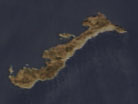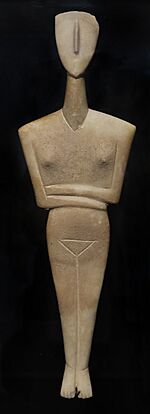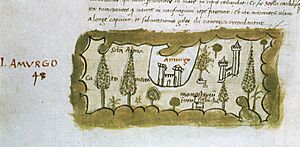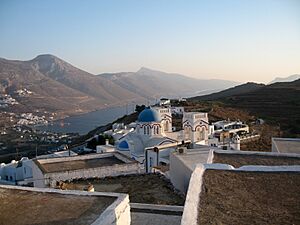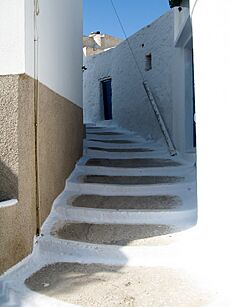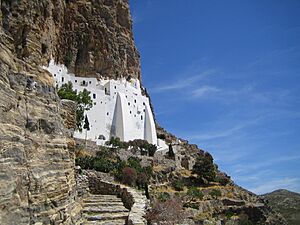Amorgos facts for kids
Quick facts for kids
Amorgos
Αμοργός
|
|
|---|---|

View of Chora (Amorgos)
|
|
| Country | Greece |
| Geographic region | Cyclades |
| Administrative region | South Aegean |
| Regional unit | Naxos |
| Area | |
| • Municipality | 126.35 km2 (48.78 sq mi) |
| Highest elevation | 823 m (2,700 ft) |
| Lowest elevation | 0 m (0 ft) |
| Population
(2021)
|
|
| • Municipality | 1,961 |
| • Municipality density | 15.520/km2 (40.198/sq mi) |
| Community | |
| • Population | 446 (2021) |
| Time zone | UTC+2 (EET) |
| • Summer (DST) | UTC+3 (EEST) |
| Postal code |
840 08
|
| Area code(s) | 22850 |
| Vehicle registration | EM |
Amorgos (Greek: Αμοργός, Amorgós) is a beautiful Greek island. It is the easternmost island in the Cyclades group. It is also very close to the Dodecanese islands.
Amorgos and its 16 smaller islands form a municipality. The largest of these small islands is Nikouria. The total land area of Amorgos is about 126.346 square kilometres (48.782 square miles). In 2021, about 1,961 people lived there.
Contents
Where is Amorgos Located?
Amorgos is located near ancient cities like Miletus and Ephesus. Because of this, it was one of the first places where people from Ionia traveled through. They used Amorgos to reach the other Cycladic Islands and the Greek mainland.
What is the History of Amorgos?
Amorgos has had many names throughout history. Some of them were Yperia, Platagy, and Karkisia. The island has many old ruins from ancient civilizations.
During the time of Archaic Greece, Amorgos had three independent city-states. These cities likely had their own rules but shared the same money. Amorgos is known for its strong city walls, old towers, and ancient tombs. Many old tools, writings, and vases have also been found here.
One of the main settlements was Arcesine (also called Arkesine). It was an important town in ancient times.
Life in the Early Cycladic Period
Archaeological digs show that Amorgos was very active during prehistoric times. This was especially true during the first period of the Cycladic civilization (3200 to 2000 BC).
Many ancient settlements were found from this period. Amorgos is famous for its unique Cycladic figurines. These are small statues, often of people. The 'Dokathismata style' figurines were first found here. Many Cycladic sculptures were discovered in old cemeteries around the island.
The 'Kapsala Cycladic figurines' date back to around 2700 B.C. They are named after a place in Amorgos where they were found. These are some of the earliest types of these statues. They often show a person lying down with their arms folded.
Later, the 'Dokathismata Cycladic figurines' were made between 2400 and 2100 BC. These statues are often more slender and angular than other types.
Amorgos in Classical Times
A part of the island called Aspis once had an ancient temple. This temple was dedicated to the goddess Aphrodite.
Around 630 BC, a poet named Semonides helped start a colony from Samos on Amorgos. The island was later called Tripolis. Amorgos was also a member of the Delian League and the Second Athenian League. These were groups of Greek city-states.
The three main ancient cities on the island were Arkesini, Minoa, and Aigiali (or Melania). These cities were on the west coast. This area had natural bays and ports perfect for seaside towns and forts. Aigiali was in the northeast, Minoa in the center, and Arkesini in the southwest.
In 322 BC, a naval battle called the Battle of Amorgos took place near the island. It was fought between Athens and Macedonia.
Ancient writers said that Amorgos produced a lot of wine. It also grew olive oil and fruits. Over time, the island's name changed to Amolgon and Amourgon.
Later History: Byzantine, Ottoman, and Modern Times
In the 5th century, a bishop from Amorgos attended an important meeting in Constantinople. During Ottoman rule (from 1566 to 1829), the island was known as Yamurgi.
On July 9, 1956, a very strong earthquake hit Amorgos. This earthquake caused a large tsunami (a giant wave) that reached up to 30 m (98 ft) high in some places. The earthquake was very powerful, and it caused a lot of damage.
Villages and Communities
The municipality of Amorgos is divided into several communities. Here are some of the main ones:
- Aigiali (including villages like Agios Pavlos and Potamos)
- Amorgos (including Chora and Kastelopetra)
- Arkesini (including Kalotaritissa and Kalofana)
- Katapola (including Lefkes and Xylokeratidi)
- Tholaria (including Paralia Tholarion)
- Vroutsis (including Kamari)
Climate in Amorgos
Amorgos has a warm Mediterranean climate. This means it has mild temperatures all year round.
| Climate data for Aigiali, Amorgos (3m) | |||||||||||||
|---|---|---|---|---|---|---|---|---|---|---|---|---|---|
| Month | Jan | Feb | Mar | Apr | May | Jun | Jul | Aug | Sep | Oct | Nov | Dec | Year |
| Mean daily maximum °C (°F) | 14.9 (58.8) |
15.7 (60.3) |
17.4 (63.3) |
19 (66) |
23.7 (74.7) |
27 (81) |
27.9 (82.2) |
28.3 (82.9) |
26.4 (79.5) |
24.6 (76.3) |
20.9 (69.6) |
17.8 (64.0) |
22.0 (71.6) |
| Mean daily minimum °C (°F) | 10.8 (51.4) |
11.5 (52.7) |
12.9 (55.2) |
14.4 (57.9) |
17.6 (63.7) |
22 (72) |
23.1 (73.6) |
23.6 (74.5) |
22.2 (72.0) |
20.3 (68.5) |
17.3 (63.1) |
14.2 (57.6) |
17.5 (63.5) |
| Average precipitation mm (inches) | 179.2 (7.06) |
146.6 (5.77) |
79.4 (3.13) |
54 (2.1) |
7 (0.3) |
1 (0.0) |
0 (0) |
0 (0) |
8.3 (0.33) |
16.5 (0.65) |
46.6 (1.83) |
86.1 (3.39) |
624.7 (24.56) |
| Source: http://penteli.meteo.gr/stations/amorgos/ (2019 - 2020 averages) | |||||||||||||
What Can You See and Do in Amorgos?
One of the most famous places to visit is the monastery of Panagia Hozoviotissa. It is built right into the side of a cliff! It was built a long time ago to protect a special religious icon from the year 812. Visitors can see the icon inside the monastery.
If you visit, remember to dress respectfully. Men should wear long trousers, and women should wear a skirt or a wrap that goes down to their knees. The monastery is still active and has monks living there.
Tourism is growing slowly on Amorgos. It's a bit harder to reach than some other Greek islands because you can only get there by boat. The main places to stay are in Katapola, Aegiali, and Chora.
The island is great for outdoor activities. You can go hiking on its well-kept paths. Other fun things to do include scuba diving and free-diving. While Amorgos has beaches, they are not its main draw like on some other Greek islands.
Another interesting landmark is a group of old windmills. You can see them on a hill above Chora, the main town. Some of these windmills can be visited, while others are ruins. It's easy to get there by car or by walking through Chora. There is no fee to enter the area.
See also
 In Spanish: Amorgos para niños
In Spanish: Amorgos para niños



